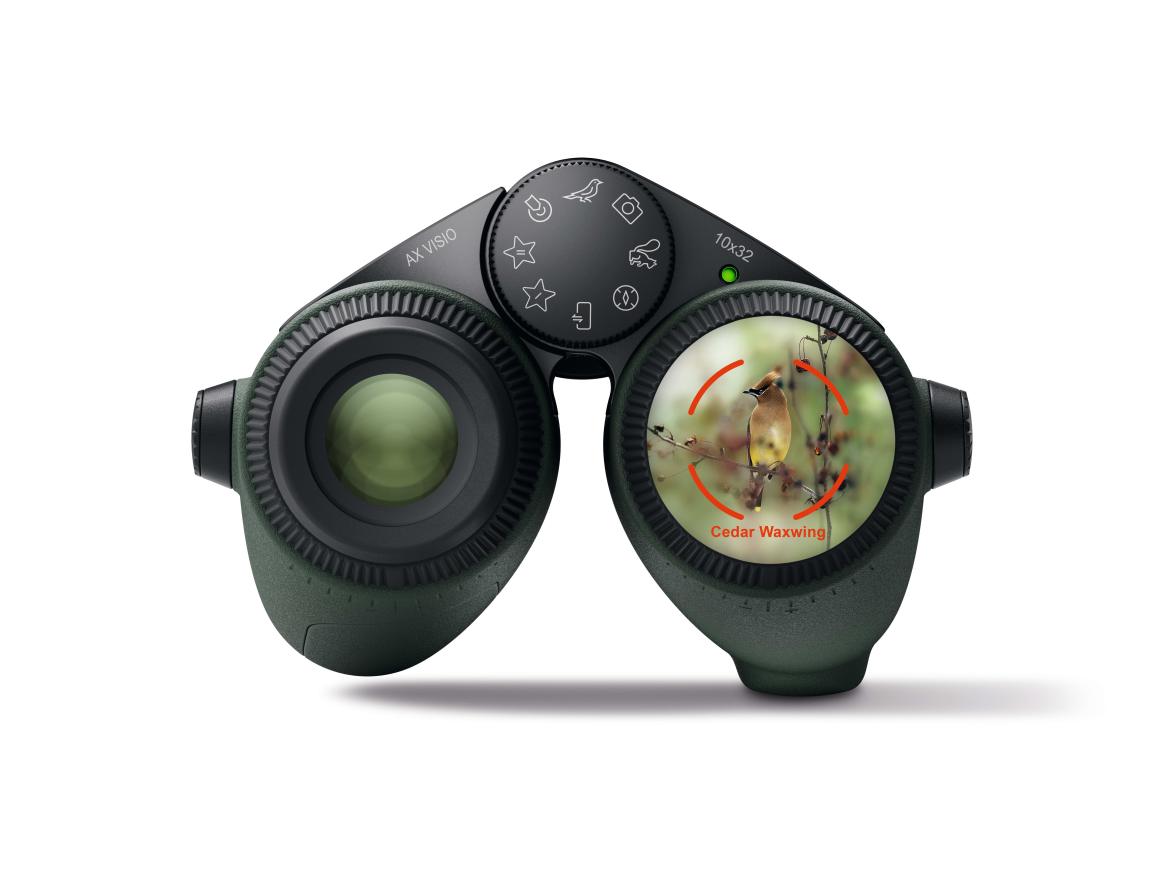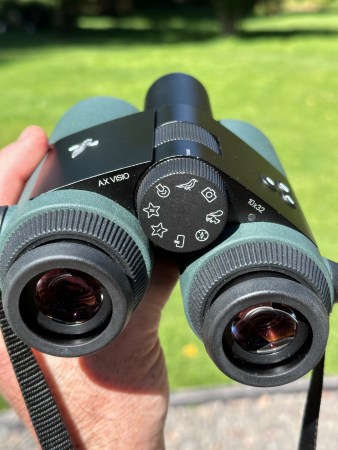We may earn revenue from the products available on this page and participate in affiliate programs. Learn More ›
Glass. Identify. Photograph. Document. Share.
Activating those verbs is the value proposition of Swarovski’s new AX Visio electronic binocular, which gives birders an entire field guide literally at their fingertips, and then the ability to share their sightings.
Inside the chassis of this big, innovative, and expensive binocular is the entire 9,000-species Cornell University Merlin Bird ID guide, along with a mammal field guide, 13-megapixel camera, high-definition video camera, and the ability to add other digital capabilities as they are developed.
There’s so much technology in this 10×32 binocular that it’s easy to forget that its core is a very good observational optic. It is built around excellent glass, and has the velvety controls and precise handling that define Swarovski’s binoculars. But it’s fair to say that you’re not reading this story – or interested in buying the AX Visio – for its glass. You’re here for the crazy amount of technology that’s packed into the binocular’s significant 2-pound, 2-ounce build. It’s also fair to note that all that technology has optical costs; the AX Visio has about 15 percent less light transmission than Swarovski’s non-electronic 10×32 NL Pure binocular, because the displays inside the Visio require additional lens elements, which block light.
Swarovski describes the AX Visio, which it introduced in January but is still not widely available, as “the first smart binocular” that represents “the future of observation.” While those are pretty grandiose characterizations, the binocular does contain some revolutionary features that are bound to disrupt the fairly staid and restrained world of birding and which could give big-game hunters a glimpse into a future in which AI and image-categorization becomes normalized in our field optics.
The AX Visio’s onboard bird ID will appeal to beginning and mid-career birders who may not have easy facility with the dizzying number of species, subspecies, and regional variations of birds. And the community features enable birders to easily capture images and then share them across social media or other platforms. But, as we’ll detail below, not all birders are fans of the technology.
Swarovski AX Visio at a Glance
Key Features
- 10×32 configuration
- Onboard 9,000-species Merlin Bird ID
- 13 MP camera
- HD video camera
- Connects to Swarovski Optik Outdoor app
- Mammal field guide
- Share Discovery feature
- Price: $4,800
Pros
- Real-time bird identification
- Very good optics
- High-resolution camera
- App enables live display feature
Cons
- At about $4,800, very expensive
- Bird ID requires correct light and aspect
- Physically heavy and large
How the Swarovski AX Visio Works
To activate both identification and imaging capabilities, you simply focus on a bird and power up the binocular’s electronic brain. The red LED display flashes a circle — large or small, depending on the size of and distance to the bird — and when you push the ID button, the optic finds a match in the onboard Merlin field guide. The name of the bird is then displayed in the viewfinder. Users can then take a high-resolution photo of the bird, video it in high-definition, and then upload the image to a Bluetooth-connected mobile app.
The app also allows for a live-view feature, meaning that any image that is seen through the binocular can simultaneously be displayed on a phone screen.
Testing the AX Visio in the Field
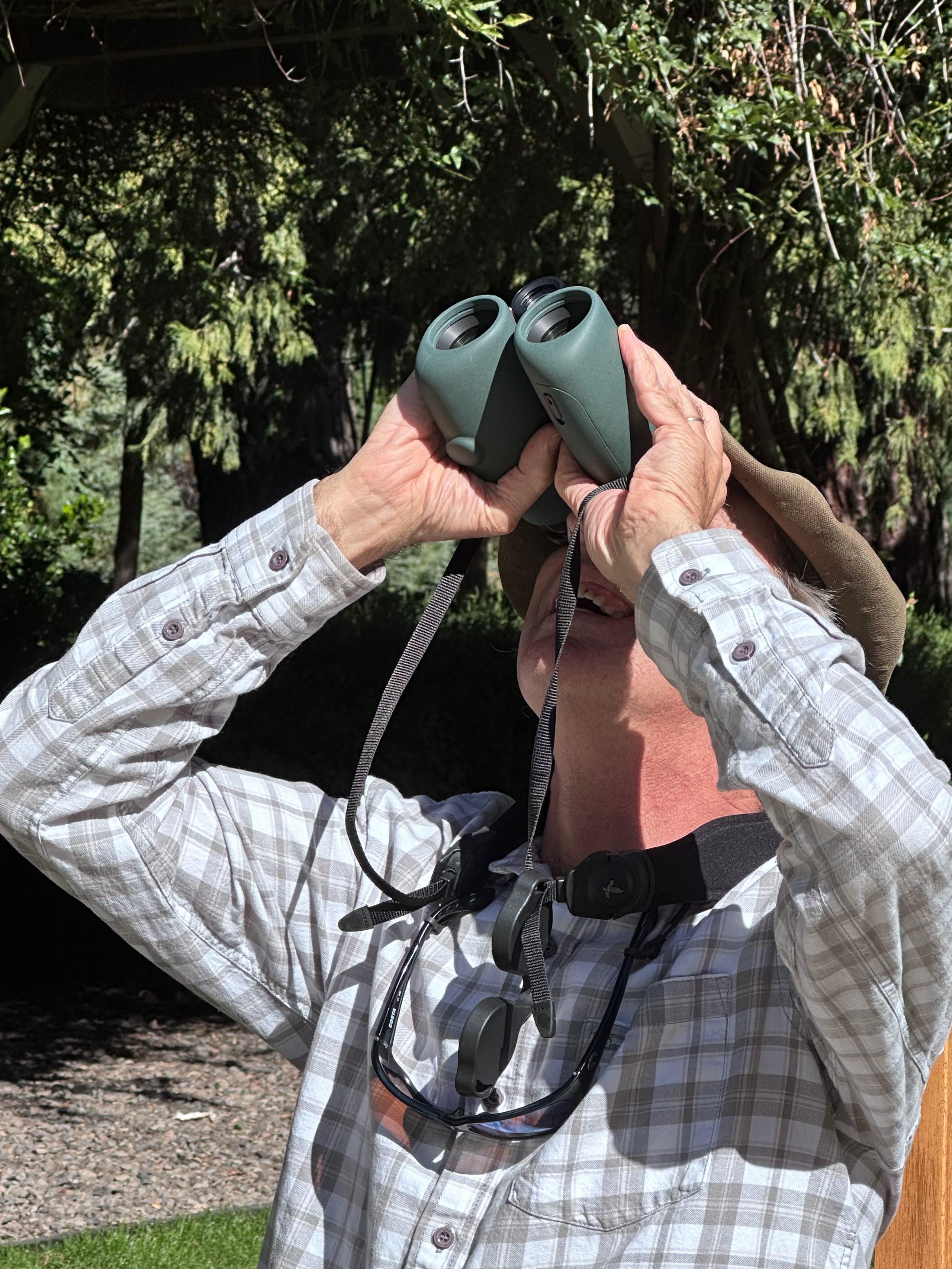
Andrew McKea
I played around with the bird ID feature during a test session in Argentina last month, and was impressed by its capabilities. I was able to tease out the image of a bird deep in a confusion of limbs, and got a positive ID (rufous-tailed plantcutter). Later, I stalked a peacock in similarly obscuring cover and tested the Swarovski, which gave me the bird’s formal name (Indian peafowl). I was even able to positively ID a raptor (cinereous harrier) on the wing, flying about 300 feet above the pampas.
But the ID feature doesn’t always work that well. In several cases, I got either misidentifications or the optic could not positively ID birds. If the bird was backlit, or the bird was obscured by brush, or if the bird gave me an oblique angle, the optic often couldn’t perform as advertised. That’s not a surprise, given the weak inputs, but it did assure me that the AX Visio does have occasional blind spots.
Of further interest to birders, the binocular’s memory will store not only the names of birds that it has ID’ed, but also their location on a map that’s tied to Swarovski’s smartphone app, which is called Swarovski Optik Outdoor App. That’s a feature that can be used to document sightings and add to birders’ life lists.

If users want to photograph or video birds (or presumably anything else), additional settings activate the 13 MB camera, which is about the same as the camera on an iPhone 13, or the video camera that shoots in either 640×480, 1280×720 HD, or 1920×1080 Full HD modes.
Any content captured by the binocular, from videos to bird identifications and locations, can be shared via the Swarovski mobile app, which is configured for both IOS and Android devices. But there’s a significant additional sharing feature that will appeal to anyone who has ever tried to describe a distant target or animal to a friend, using landmarks or noteworthy features to “walk” them into the object of your attention.
“It’s just right and above that white rock that’s below the oak tree,” and “Just follow the ridgeline up, and before you get to the saddle, look in the shade of that yucca.” Those descriptions that make perfect sense to you are often lost on your companion, but Swarovski has found a better way.
Set the binocular on the “Share Discoveries” function and mark your object by pressing a button. Then pass the binocular to your companion and the device will use compass headings and lighted arrows to lead them to the object you marked. It’s a simple and elegant way to share sightings without gesticulating wildly or using inadequate words and descriptions.
Additional Features
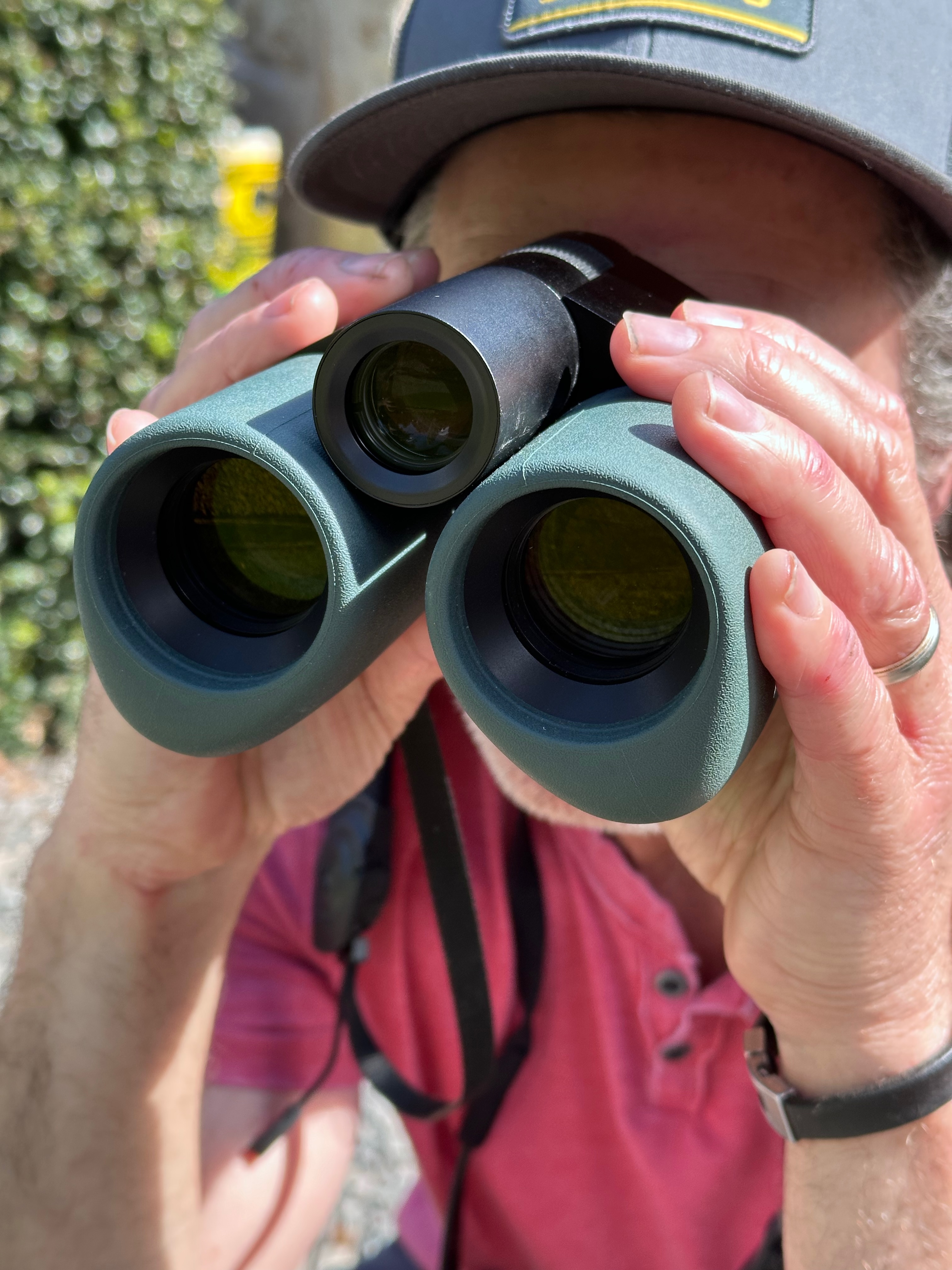
Andrew McKean
The AX Visio has a mammal identification feature that fetches names from an onboard library of common species. I didn’t mess with this much in Argentina, but I doubt it has the extensive field guide of the Merlin Bird ID, which the world-leading Cornell Lab of Ornithology developed. However, I can foresee the mammal ID feature growing as more hunters and wildlife watchers invest in the platform and use it to catalog their sightings.
Of equal interest are two functions that are not yet assigned. These are displayed as stars on the center function wheel of the AX Visio, and they’re essentially place-holders that will accommodate digital features of the future. One possibility that a Swarovski representative discussed with me is an antler-scoring function that would use AI and a library of representative antlers to give users a ballpark score of a big-game animal.
Imagine glassing a buck with the Swarovski, hitting the Score button and learning in real time that it’s a 140-class typical whitetail, or that it’s a 212-inch non-typical. While the feature might be considered extraneous or even heretical by some hunters, it would certainly come in handy on those properties that have a minimum score requirement for hunters.
The other unassigned function? Maybe it’s an insect field guide, or an astronomical guide to the night sky, or even an ethics module that alerts hunters if an animal is too far for their ballistics and demonstrated proficiency, or if the quartering-toward aspect of the animal presents a low-odds shot.
Swarovski has indicated that it would entertain any functions that are built around open-source code and can add value to their platform.
Disruptive Technology
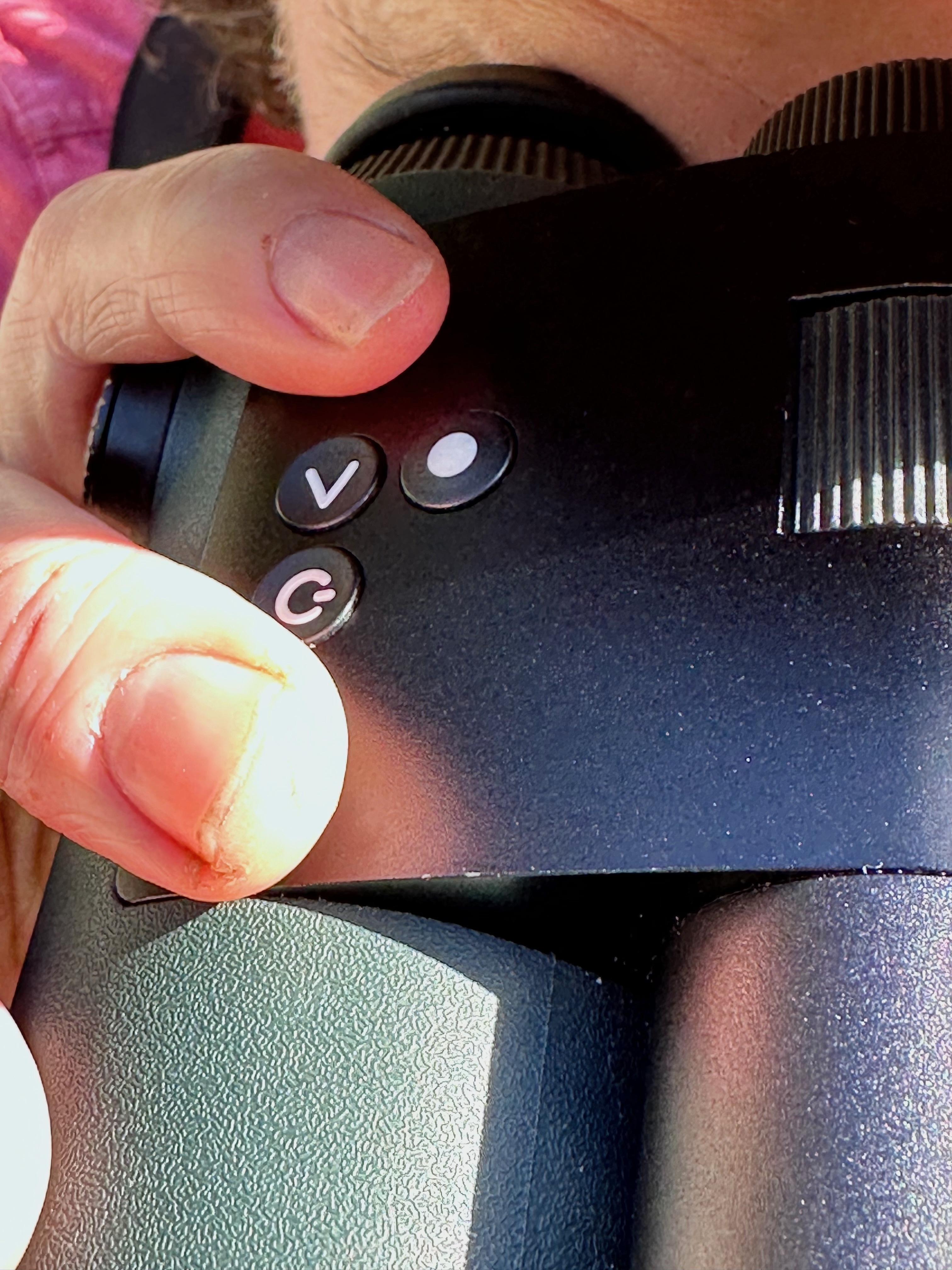
Andrew McKean
If you think we have schisms in our hunting communities — traditional archers vs compound hunters or hound hunters vs spot-and-stalk deer hunters — the birding community is even more fractured. The Swarovski AX Visio has widened some of those fissures, with some traditional birders claiming that the optic’s onboard technology will make birders “lazy” or will “take the fun out of birding” by literally giving users an easy button.
These critics are concerned that the technology will short-cut the foundational work that most birders have embraced: learning species by observing them, then consulting analog field guides, then observing them again in a back-and-forth process that gradually builds aptitude and awareness. Critics of the Swarovski claim that if users simply have only to push a button every time they observe a bird, they won’t appreciate the unique habitats or seasonality of birds, all considerations that amplify the conservation ethics of serious birders.
It’s worth noting that this same controversy is coloring the use of the Sound ID feature of Cornell’s Merlin bird app, one that I’ve used myself. You can record a clip and the app will identify birds in your surroundings by its distinctive call. Some birders claim this, too, is a shortcut that will ultimately devalue the intensive fieldwork and dedication that serious birders embrace.
Final Thoughts on the Swarovski AX Visio
Those are all legitimate opinions, but they’ve also become expected perspectives on the intrusion of technology in our traditional field sports.
I prefer to dwell instead on the merits and limitations of Swarovski’s new “smart binocular.” Its technology is good but not great, since it requires the right combination of distance, light quality, and background to make positive identifications. Its optics are excellent, but not quite as good as Swarovski’s flagship binoculars. The AX Visio is a brick, over 2 pounds and a big handful that will be difficult for youth and some smaller adults to handle. The 10-foot close focus is good but not great for insect and butterfly observers. The rechargeable battery is big, and the 2-hour run time at maximum use will frustrate some users who come to rely on its technological attributes.
The AX Visio is wildly expensive. Who has nearly $5,000 to drop on an optic? Swarovski is smart to pursue the relatively affluent birding community, because birders are more likely to invest in quality optics compared to other user groups.
But in terms of the AX Visio’s main capability, its ability to immediately identify a distant bird, is very satisfying. And once you know the bird, the secondary technology enables a human need to share that knowledge. With that in mind, the Swarovski is fully capable of not only defining our world, but also enlarging it.
